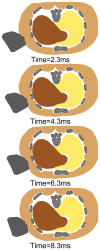Blunt liver injury with intact ribs under impacts on the abdomen: a biomechanical investigation
- PMID: 23308111
- PMCID: PMC3538640
- DOI: 10.1371/journal.pone.0052366
Blunt liver injury with intact ribs under impacts on the abdomen: a biomechanical investigation
Abstract
Abdominal trauma accounts for nearly 20% of all severe traffic injuries and can often result from intentional physical violence, from which blunt liver injury is regarded as the most common result and is associated with a high mortality rate. Liver injury may be caused by a direct impact with a certain velocity and energy on the abdomen, which may result in a lacerated liver by penetration of fractured ribs. However, liver ruptures without rib cage fractures were found in autopsies in a series of cases. All the victims sustained punches on the abdomen by fist. Many studies have been dedicated to determining the mechanism underlying hepatic injury following abdominal trauma, but most have been empirical. The actual process and biomechanism of liver injury induced by blunt impact on the abdomen, especially with intact ribs remained, are still inexhaustive. In order to investigate this, finite element methods and numerical simulation technology were used. A finite element human torso model was developed from high resolution CT data. The model consists of geometrically-detailed liver and rib cage models and simplified models of soft tissues, thoracic and abdominal organs. Then, the torso model was used in simulations in which the right hypochondrium was punched by a fist from the frontal, lateral, and rear directions, and in each direction with several impact velocities. Overall, the results showed that liver rupture was primarily caused by a direct strike of the ribs induced by blunt impact to the abdomen. Among three impact directions, a lateral impact was most likely to cause liver injury with a minimum punch speed of 5 m/s (the momentum was about 2.447 kg.m/s). Liver injuries could occur in isolation and were not accompanied by rib fractures due to different material characteristics and injury tolerance.
Conflict of interest statement
Figures





References
-
- Snedeker JG, Barnstuble BB, Iaizzo PA, Farshad M, Niederer P, et al. (2007) A comprehensive renal injury concept based on a validated finite element model of the human abdomen. J Trauma 62: 1240–1249. - PubMed
-
- Vock R (2001) Liver rupture caused by isolated blunt force impact: the result of a blow, a kick or a fall? Int J Legal Med 114: 244–247. - PubMed
Publication types
MeSH terms
LinkOut - more resources
Full Text Sources
Other Literature Sources

